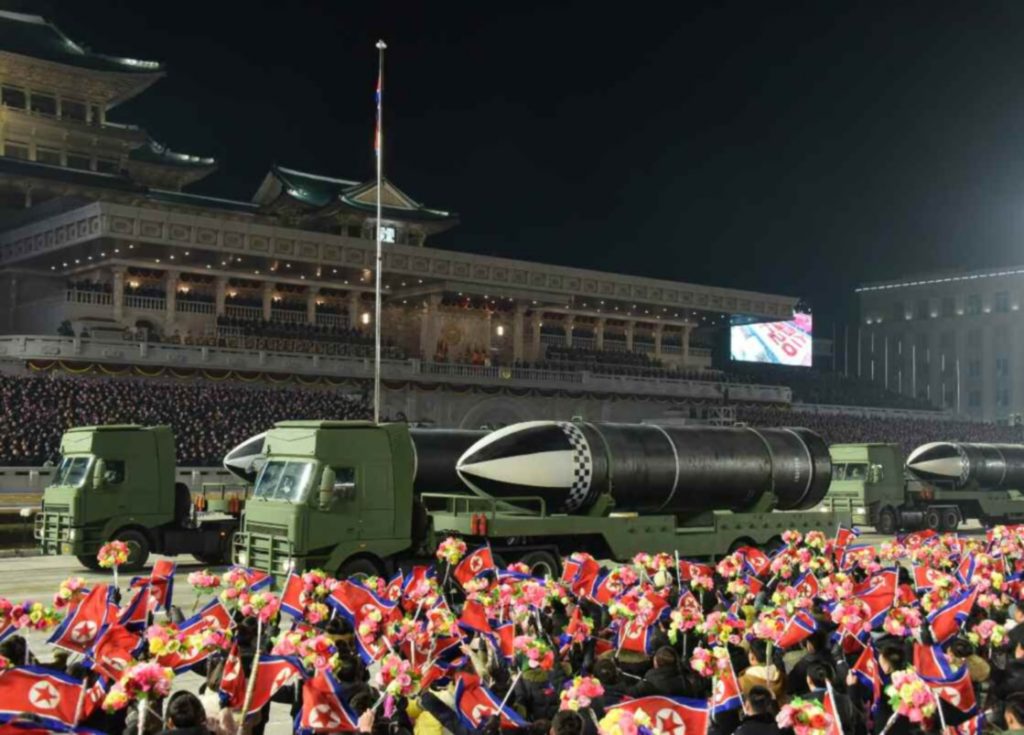North Korea’s Newest Submarine-Launched Ballistic Missile, Same as the Old One?
Last week, North Korea’s leader Kim Jong Un presented a detailed report to the Eighth Congress of the Workers’ Party of Korea highlighting the nation’s successes in building a nuclear force while also laying out the party’s plans for the next five years. Kim pledged to “further strengthen the nuclear war deterrent” by developing and fielding several new systems, including “ultra-modern tactical nuclear weapons,” “hypersonic gliding flight warheads,” “multi-warhead” missiles, reconnaissance satellites, a nuclear-powered submarine, and solid-fuel, land- and submarine-launched, and intercontinental ballistic missiles (ICBMs).[1] However, these ambitious projects will take years to develop fully. At the very least, North Korea will need to subject the new systems to testing programs that are visible to outside observers, thereby providing advanced warning of any new capabilities.
The Latest Military Parade
A few days after the Party Congress concluded, Kim oversaw North Korea’s latest military parade on the evening of January 14. The parade featured a variety of tactical missiles with ranges below 1,000 km, three of which have already been flight tested and are likely deployed with the military. These operational systems include the “super-large” multiple-launch rocket system (MLRS), designated KN-25 by US intelligence, as well as the KN-23 and KN-24 precision-guided missiles seemingly inspired by the Russian Iskander and the US Army Tactical Missile System (ATACMS), respectively.
A new tactical missile was presented at the tail end of the parade, carried in pairs on a five-axle transporter-erector-launcher (TEL). The missile’s external dimensions cannot be determined with confidence, although the diameter is likely about one meter, which translates to an estimated range of 700 to 900 km. No aerodynamic surfaces or fins can be seen, suggesting the missile relies on jet vanes inserted into the exhaust gases for directional and attitude control during the boost phase.
The lack of aerodynamic surfaces also indicates that it performs like a standard ballistic missile, traveling on a parabolic arc toward the target, unlike the KN-23 and KN-24, which rely on flattened trajectories that do not exit the earth’s atmosphere and use fins to provide post-boost and terminal maneuverability. The new missile is assumed to be powered by solid fuel, although there is no definitive indicator of that.

The parade also introduced yet another submarine-launched ballistic missile (SLBM), designated the Pukguksong-5. The missile’s external dimensions are consistent with the Pukguksong-4 presented during the North’s October 2020 parade (roughly 1.8 meters in diameter), although the payload shroud is slightly longer, giving it an estimated length of about 10.5 meters compared to 9.8 meters for the Pukguksong-4. According to one source, the Pukguksong-3 unveiled in 2019 has the same dimensions as those of the Pukguksong-4 and -5. These dimensional similarities indicate North Korea is still in the process of settling on a specific design for its next-generation SLBM. There have been no reports of North Korea ground testing large solid-rocket motors recently, another indication that the Pukguksong-5 design remains on the drawing board.
It is difficult to assess the Pukguksong-5’s potential performance envelope. The paraded mock-ups lack the external details that might provide clues about its configuration. Nonetheless, its dimensions are remarkably similar to those of the US Poseidon SLBM, which consists of two solid-fuel stages capable of hurling multiple warheads to more than 4,600 km. Poseidon was a highly optimized missile, however, loaded with high-energy propellants contained in light-weight casings made from fiberglass, and piloted by a very sophisticated navigation, guidance and control package. It also featured rocket exhaust nozzles submerged within the rocket stages to reduce its overall length, allowing it to be deployed in the confined launch tube. The Pukguksong-5 is likely to be more rudimentary in design, construction, and solid-propellant technology, and therefore to have a more limited range of about 3,000 km. A 3,000-km missile could strike Guam from roughly the center of the East Sea (Sea of Japan).
No ICBMs
The parade did not feature any of North Korea’s long-range missiles from the Hwasong series. There were also no solid-fuel intercontinental ballistic missiles or mock-ups of hypersonic glide vehicles, despite having been discussed in the Party Congress. It seems Kim was content with displaying the country’s tactical, land-based missiles and a large SLBM for this showing.
- [1]
“Great Programme for Struggle Leading Korean-style Socialist Construction to Fresh Victory On Report Made by Supreme Leader Kim Jong Un at Eighth Congress of WPK,” Rodong Sinmun, January 10, 2021; and “WPK General Secretary Kim Jong Un Makes Concluding Speech at Eighth Congress of WPK,” January 13, 2021, https://www.38northref.org/wpk-general-secretary-kim-jong-un-makes-concluding-speech-at-eighth-congress-of-wpk/.
